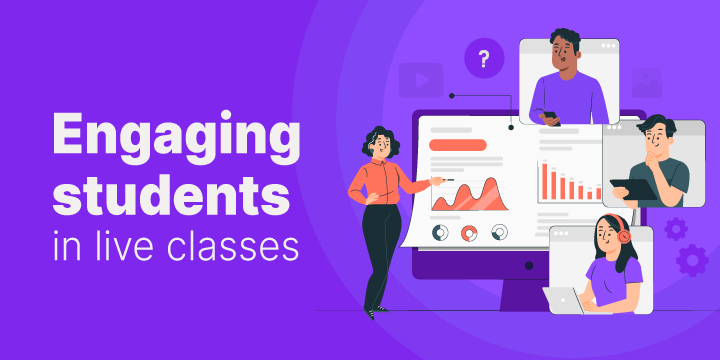Has there been a challenge as prominent as student participation when it comes to online tutoring? Over the past two years, teachers have managed to figure out the technology, learn new tools, and get comfortable with the world of online tuitions. However, there still remains one distinct mountain to climb when it comes to live class coaching online – getting the students to be involved. We have put together a few impactful techniques for you to increase student engagement and bring together a more lively digital classroom.
Thankfully, all it requires is a slight shift in mindset and a few tips and tricks to create a truly interactive involvement. The moment teachers and professors are able to stop thinking of online coaching as a poor substitute for in-person lectures and focus on the plethora of advantages it provides instead, learning can become a far more enriching experience for everyone involved.
When it comes to students, it is perhaps the K-12 students, those between the age of 5 to 17 years, that most benefit from interactive classrooms. Engaging in lectures does not just help academically, but also provides them with essential social skills.
K-12 Tutoring – The Critical Connection
As mentioned earlier, students between kindergarten and 12th grade in particular benefit immensely from an engaging classroom environment. Either they belong to age groups that have limited experience in in-person learning, or are facing experiences that may seem overwhelming by themselves. An interactive online classroom benefits them holistically as it gives them a space to connect with peers, form friendships, and be part of a comforting environment.
The importance of engaging digital classrooms is quite clear, but how do you create such a space for students? Here are a few tips that will help:
Well Begun Is Half Done
It is essential to start on the right note and establish upfront the kind of digital classroom you wish to create. If you are about to start working with a new batch of students, ensure that your first session focuses on creating a welcome atmosphere. Help students feel connected with each other through ice breakers, fun games, and interactive seminars. Think of new and innovative ways they could introduce themselves or ways in which they could find peers they have something in common with.
Additionally, creating an environment where students feel comfortable with switching their cameras on is just as important. Sure, you could make it mandatory. But you know you have a truly invested class when the students do it themselves.
A few ice-breaker ideas that could help students feel comfortable with each other, and you!
Emojis Speak Louder Than Words
The students’ microphones do not always have to be on for you to create an interactive session. The Chat function on the platform of your choosing can be of great aid to you. Encourage students to respond to what is being taught through emojis, or even simple thumbs up and down symbols. This would mean that students do not just have to wait to speak one at a time.
Through this approach, the chat feature can become a more proactive tool for them to utilise and constantly participate in your lectures. It is also an excellent way for you to assess just how well the class understands a topic. Students will not have to wait until you stop speaking to ask their questions.
Make The Most Of Your Tools
There are an extensive number of tools that can help you make sessions even more interactive. For example, the WISE App lets you create discussion boards that each and every student can contribute towards. Setting aside time to use such boards at the end of a lecture can ensure that students have immediate discussions about what they just learned.
Similarly, breaking the monotony of lectures can help increase the attention and engagement of students. Use apps like WISE to create and host pop quizzes — it will keep them on their toes, and WISE will provide you with immediate answers, saving you an incredible amount of effort.
Check out some of the test-creation tools at your disposal at WISE.
Flip The Classroom
You have taught the lessons. All the content for a particular topic is covered. Now is the time for you to flip the session. Let students summarise what they have been taught so far. Encourage them to share additional resources such as videos or articles that they may have found online to help others understand the topic better. Use functions like breakout rooms to create smaller discussion circles, with each group noting down their learnings, insights, and inputs onto a document.
Flipping the classroom puts the onus on the students to contribute proactively and work with each other in explaining a topic. Besides, it allows you to get a sense of how well a class understands a topic while discovering new resources that could help students with exam preparation.
Here’s a video from the YouTube channel CrashCourse with Hank Green explaining how the human heart works.
Think-Pair-Share
If your classroom flipping sessions receive an immensely positive response, take your lectures to the next level. Use the think-pair-share methodology to navigate the entire curriculum. After explaining a particular topic, give students the time to think about what they have just learned. Let these views form the foundation of the questions that you share with the classroom.
Create pairs of students who will work together on answering these questions, either through third-party resources or a presentation of their own. Finally, encourage each group to share what they have learned with others. Create a common information resource wherein everyone can include the content they found helpful.
By mixing up the pairs and addressing various questions over time, you can help create a stronger bond within the classroom and ensure higher participation throughout your lectures. If you are teaching students within the K-12 group, this will also help them develop their social skills and learn how to interact and work with others in a cohesive manner.
A quick introduction to Think-Pair-Share for you.
Foster A Community
![]()
Remember, every classroom can be a community — especially on digital media, where there are several ways to initiate group conversations and stay in touch. A WhatsApp group is essential in today’s day and age, but make sure it is not just used to provide lecture updates.
Learning today should include all the content available online — ranging from Twitter threads and Facebook posts to Netflix documentaries. Through your WhatsApp group, you can share links to Instagram pages, YouTube channels, or even websites that others would enjoy. Encourage students to ask questions in these shared spaces and for others to monitor them. Celebrate birthdays, achievements, big moments, as well as small joys. Once you get the ball rolling, the students themselves will sustain the community. All you need to do is be a part of it.
Encourage face-to-face interactions
No matter the efforts you take, students studying at online tuitions can often be in the midst of a distracting environment. Besides, with the world at their disposal through the internet, students can get easily distracted. Switching tabs, literal and mental, does not take too long for them.
Encourage students to keep their cameras on, without making it seem like a mandatory expectation. Showcasing a little flexibility, and letting them switch them off for a few minutes if needed, can mean that participants feel like they have voluntarily taken this decision.
Empathy can play a significant role in helping students switch their cameras on. It is one of the topics this video touches upon while discussing ways to increase participation.
Communicate, Communicate, Communicate

At the end of the day, the only way to get answers is by asking questions. You will never know if students are struggling to interact during sessions unless you ask them. Shy or disinterested students may get lost in particular in a virtual classroom setting, so it is vital to reach out to them in particular. Circulating anonymous forms and setting up virtual office hours can be a great start. When possible, work on providing one-on-one consultations with students to understand where they stand and build a concrete connection.
The feedback you receive will also play a crucial role in helping you plan your lectures better. Keep in mind though, that not every student will be honest upon being asked questions directly, so keeping an anonymous medium for them to reach out to you will certainly help.
Get It Together, And Get Going!

There you have it! A few tips and tricks that will help you create a far more engaging and interactive environment for students, therefore increasing participation. So, get your action plan in place, make a few tweaks to your teaching style, and prepare yourself for a far more present and proactive classroom. Don’t forget all the tools you can use, such as WISE, to make your virtual classroom an even more engaging space!




